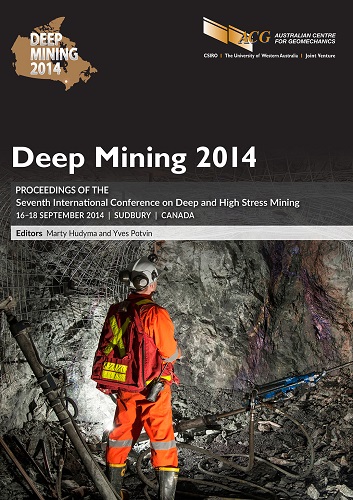Liquid air for energy storage, auto-compression, compressed air and ventilation in deep mining

|
Authors: Cluff, DL; Kennedy, GA; Foster, PJ |
DOI https://doi.org/10.36487/ACG_rep/1410_54_Cluff
Cite As:
Cluff, DL, Kennedy, GA & Foster, PJ 2014, 'Liquid air for energy storage, auto-compression, compressed air and ventilation in deep mining', in M Hudyma & Y Potvin (eds), Deep Mining 2014: Proceedings of the Seventh International Conference on Deep and High Stress Mining, Australian Centre for Geomechanics, Perth, pp. 757-770, https://doi.org/10.36487/ACG_rep/1410_54_Cluff
Abstract:
Deeper mining projects necessitate that ground control in high stress environments, ventilation and heat stress management be extended to the limit of current technologies; thus represent substantial research and development efforts to realise safe and profitable deep mining. In this paper, a concept is presented that serves to advance the potential for providing services and infrastructure for deep mining at potentially reduced costs. Liquid air (LA) is an energy storage vector that provides the opportunity for energy cost arbitrage through peak shaving or by smoothing the operation of wind turbines or solar power systems. By producing LA during operation of the wind turbines or during daylight hours and releasing the energy during low wind periods or evenings, the energy can be distributed more economically over time The infrastructure required for LA facilities is a reliable mature technology and competitive with competing energy storage systems. As the mine depth increases, a LA energy storage system can deliver more than just energy storage, because a LA system may reduce the amount of some critical financial variables. For example, LA can deliver: chilling to offset auto-compression, improvements to ventilation on demand, rapid rock skin temperature conditioning, heat absorption at depth, arbitrage of electrical energy cost shifting, compressed air supply and operation of large vehicles. The Dearman engine uses LA as a fuel, consequently when it is employed in trains, scoops and other equipment the exhaust of the large underground equipment becomes a source of cool air, which further reduces the ventilation required because dilution of diesel and removal of heat generated by equipment is no longer part of the ventilation calculation. LA can provide compressed air, routinely used to operate equipment or provide emergency ventilation. The losses in compressed air systems from long distance delivery and leaks en route, a common complaint of mine managers, are offset by using underground LA expansion; further absorbing heat and the proximal storage of the liquid air source near the compressed air module reduces line losses. Electricity can be generated using modular gensets so the cost of electricity substations and high voltage trunk lines to underground are replaced or supplemented by using modular underground LA electricity generation. Stirling engines are capable of operating efficiently between the LA and ambient temperatures at high efficiencies and can be used for heavy duty pumping, milling or electricity generation. The efficiency of Stirling engines can be further increased by using a solar collector with a high temperature heat storage system, such as oil or nitrate salts, to increase the efficiency. All uses of LA benefit from a higher rock temperature as the depth increases because the Carnot efficiency of a heat engine increases as the temperature difference increases. Numerical modelling of the interaction between the LA introduced to a ventilation flow and the rate of heat absorption from the underground rock surfaces is presented. The effect on ventilation pressure due to the expansion of the LA is described.
References:
AngloGold 1999, ‘Mine Energy Guidelines, Analysis of energy usage in future AngloGold mines’, contract no. AG000216, CSIR Mining Technology, 2002, Mine Energy Guidelines, Guidelines for phase one of Deep Mine: 1997 – 2002, Deep Mine Collaborative Research Programme.
Beiro-Romero, M & Cluff, DL 2013, ‘Deep Mine Ventilation: Using Liquid Air as a Source of Ventilation’, research thesis CSM 3357, University of Exeter, Exeter.
Bossard, FC 1993, ‘Calculating underground mine air cooling requirements’, in R Bhaskar (ed.), Proceedings of the 6th US Mine Ventilation Symposium, Society for Mining, Metallurgy and Exploration, Englewood.
Cluff, DL, Kennedy, GA & Bennett, JG 2013, ‘Capturing energy from ventilation air methane at operating coal mines’, Proceedings of the 23rd World Mining Congress 2013, paper 582,
Cluff, DL 2014, ‘Concepts in Coalmine Ventilation and Development of the VamTurBurner for Extraction of Thermal Energy from Underground Ventilation Air Methane’, PhD dissertation, University of Exeter, Camborne School of Mines, Exeter.
Department of Climate Change and Energy Efficiency 2010, Supplementary Discussion Paper on Compliance Obligations and Enforcement Measures for the Proposed National Legislation for Minimum Energy Performance Standards (MEPS) and Energy Labelling, Department of Climate Change and Energy Efficiency Report 2010/05, viewed 14 July 2014,
Du Plessis, J, Butterworth, M & McIntyre, R 2012, ‘Ventilation and cooling strategy for a deep mechanised mine – South Deep in South Africa’, ICMM Second Health and Safety Conference, Poster Session, International Council on Mining and Metals,
Hilt, D, Cauley, G, Barber, PF, Boston, WT, Fidrych, M, Jones, SR, Mansour, Y, McMaster, DM, Newman, WK & Winter, TM 2004, ‘Technical Analysis of the August 14, 2003, Blackout: What Happened, Why, and What Did We Learn?’, report to the NERC Board of Trustees by the NERC Steering Group July 13, North American Electric Reliability Council, Princeton,
McIvor, A 2010, ‘Mining and Energy’, Cleantech Magazine – Fuel Cell Special, Sept/Oct 2010, viewed 11 July 2014,
Navarro-Torres, VF & Singh, RN 2011, ‘Thermal State and Human Comfort in Underground Mining’, in MA dos Santos Bernardes (ed.), Developments in Heat Transfer, InTech Europe, Croatia.
Strahan, D (ed.) 2013, Liquid Air in the energy and transport systems: Opportunities for industry and innovation in the UK – Full Report, report no. 21, The Centre for Low Carbon Futures,
© Copyright 2025, Australian Centre for Geomechanics (ACG), The University of Western Australia. All rights reserved.
View copyright/legal information
Please direct any queries or error reports to repository-acg@uwa.edu.au
View copyright/legal information
Please direct any queries or error reports to repository-acg@uwa.edu.au